A maritime trading network connected Constantinople to most of the known world – and beyond. Here is some background for our Ship Saga Farmann´s epic voyage in the wake of the Vikings.
By Einar Chr. Erlingsen
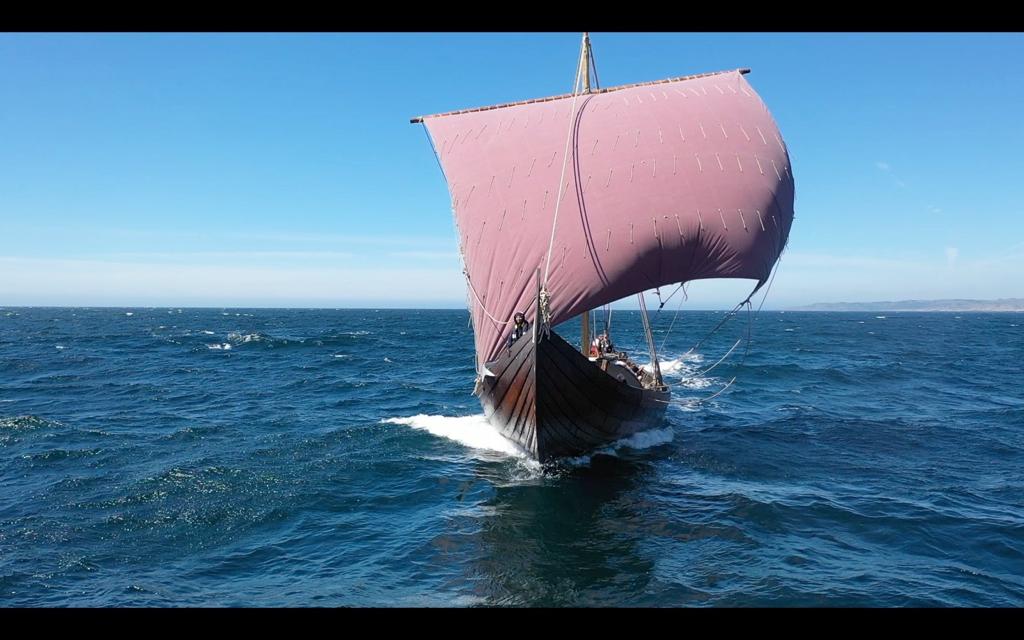
The City at the crossroads, the bridge than connects East and West – how often haven´t we heard those phrases used for describing the wonderful city of Istanbul? No city is greater, none has a longer or more dramatic history. And it is to this history that we must turn to find out more about the rich trading conditions that are reflected in the Yenikapi discoveries.
A vivid picture springs to mind: that of a young, blond Viking, probably sometimes in the late 11th Century. He stands at the upper gallery on the south side, where the balustrade circles the vast interior of the Hagia Sophia in the melting pot that was known to most of the world as Constantinople – Constantine´s city. The young Viking however, knew it in his own language as Miklagard – “the big city”.
What a revelation it must have been for the young man when he first arrived in the Emperor´s city! For two hundred ears or more it was a city of legends in his Scandinavian home; each returning warrior adding new stories of greatness, marvel and glory when they tried to describe what they had seen and experienced.
Their own culture was a wood-based one; for ships, for houses, furniture, Objects of art, almost everything. By the 9th Century, towns had barely started to emerge in Scandinavia, the few that had, were small and unimpressive. For a young man to arrive in the city of cities must have been a culture shock beyond imagination. Constantinople with its million inhabitants was bursting with life, sounds, smells, colours and people from all over the known world. Not to mention the towering Hagia Sophia – then the largest cathedral in Christianity, with its enormous dome that seemed to float in thin air. There were imperial palaces, the enormous Hippodrome, where horseracing teams competed for riches and glory, sometimes at the cost of their lives. The city was surrounded by enormous defensive walls up to 12 meters high, walls that it would take another 5oo years for anyone to breach, and then only at the introduction of a new weapon – the cannon.
It was to this city he had come – Halfdan. We don´t know from what part of Scandinavia he originated, but his name just might be a pointer – it literally means half Dane.
Halfdan had certainly not arrived in Miklagard alone. The road had been known amongst Scandinavians for centuries, but it was a long and hazardous passage that required massive manpower to ensure survival. Dangers lurked in many places along the more than 3000 kilometres long network of rivers, lakes and portages. It was to its time a trans-European super-highway that started way up North at the Baltic Sea and beyond and led through territories later to be known as Ukraine and Russia all the way down to the Black Sea.
But let us leave young Halfdan for a while. For the time being, he is well placed at the Hagia Sophia marble balustrade. We shall still find him there towards the end of this chapter.
Instead, let us concentrate for a while on Halfdan´s fellow travellers on the super-highway between north and south. To reach their goal, the Viking tradesmen (and sometimes: raiders) had to be brave, patient and strong. Written contemporary sources reveal how they often had to fight their way against hostile, local tribes along their route. They would also have to navigate roaring waterfalls and treacherous marshland before reaching the Great City.
Emperor Constantine Porphyrogenitus is believed to be the author of an account on such an expedition, written as part of his son´s education (AD 944). He relates how a group of tradesmen assemble in Kyiv to travel together down the Dnjepr. They would bring with them a great variety of trading goods, including slaves to be sold in Constantinople.
The first stages of their voyage were undertaken by boats, bringing them some 45 kilometres downriver to Vitichev, where they waited for merchants arriving from other directions. Then they continued further south to a stretch with seven very difficult rapids. The first three were passed afloat, but at the fourth rapid they hade to go to shore and unload their boats:
“At this barrage all put into land prow foremost and those who are deputed to keep the watch with them get out, and off they go, these men, and keep vigilant watch for the Pechenegs. The remainder, taking up the goods which they have on board the monoxyla (boats), conduct the slaves in their chains past by land, six miles, until they are through the barrage. Then, partly dragging their monoxyla, partly portaging them on their shoulders, they convey them to the far side of the barrage, and then, putting them on the river and loading up their baggage, they embark themselves, and again sail off in them.”
The seventh and last rapid was the one most notorious for attacks by the local tribe Pechenegs. Having successfully passed this last challenge, the travellers reached St Gregory´s Island in the middle of the river. There they would go ashore to make offerings of thanks for their safe passage. From there the distance was relatively short to the city of cities and centre of the trading network between East and West – Constantinople.
In importance, this super-highway could almost compete with the silk roads from the East. We shall see that the Eastern and Northern roads linked up very well and in fact supplemented each other.
A Scandinavian/Slavic dynasty in Kyiv
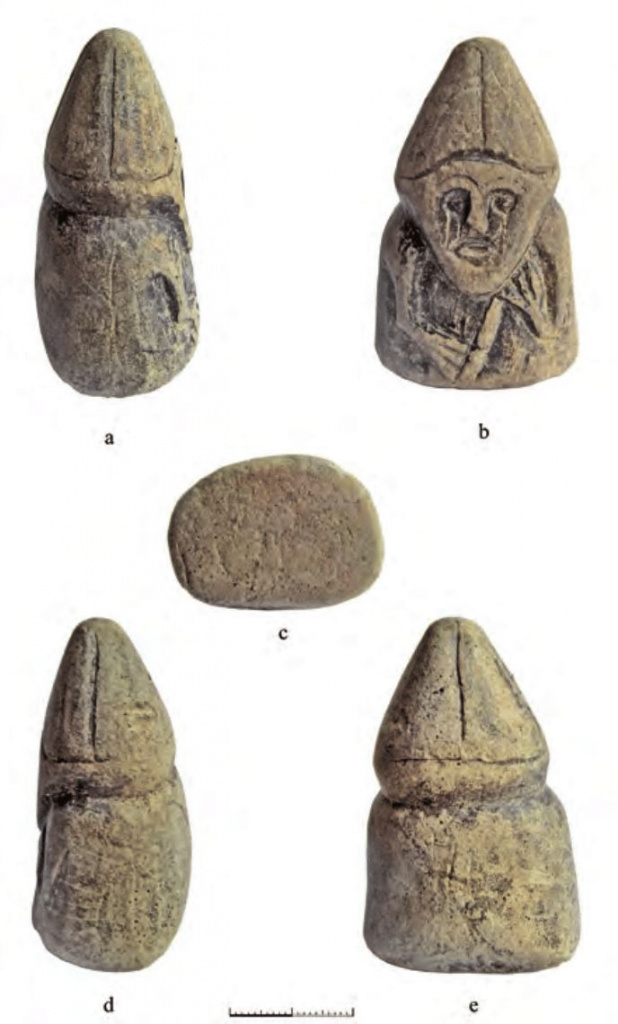
We don´t know exactly when the first Norsemen started to emerge in Constantinople via this route of lakes and rivers, but it must have been some time during the 9th Century. As the Ukrainian scholar Nestor would write three Centuries later (1113-1118) in his Kyiv cave monastery, the Slavic tribes agreed to seek leaders among the rus – their name for the people living in Scandinavia – to rule over them: “Our land is large and rich, but there is no rule of law there. Come and rule over us.” According to Nestor, this was the beginning of the great nations that further on in history would become Ukraina, Belarus and somewhat later also Russia.
The first Scandinavian ruler Rurik established his dynasty in Novgorod in AD 862. He was followed for many generations by a Slavic/Viking dynasty of rulers. Oleg (Norse name: Helge) followed Rurik and united Novgorod and Kyiv, from then on the dynasty was known under the name Kyiv-Rus.
In Constantinople, they too would soon learn that a new power was emerging in the North. Already hard pressed by Moslem forces, the emperor now had to shift focus to resist Oleg´s forces when they attacked Constantinople in AD 907. They did not breach the defensive walls, but still had to be bought off with impressive spoils. One interesting fact emerges from the peace treaty negotiated between Oleg and emperors Leo and Alexander: the names of the Kyiv-Rus envoys are all Scandinavian – fifty years after Rurik founded his dynasty: Karl, Farulv, Vermund, Hrolleiv and Steinvit. In another treaty negotiated five years later (AD 912), the first five envoys are joined by another 10 men: Ingjald, Gunnar, Harald, Karni, Frithleiv, Roar, Agentyr, Trond, Leidulf and Fast.
As time went by, Scandinavian dominance of the Kyiv-Rus ruling class would gradually diminish, but never quite be forgotten or totally disappear. More than a century after Oleg´s attach on Constantinople Norwegian kings on the run would find safe shelter amongst relatives in Kyiv. One example: the saint-king Olav Haraldsson prepared his attempt to reclaim his Norwegian throne while in Kyiv. It did not go well; he lost it all including his life on the battleground of Stiklestad in Norway in AD 1030. From the same battleground another potential king emerged; Olav´s half-brother Harald Hard Ruler (1015-1066). Only 15 years old, Harald escaped to Kyiv after the battle and was warmly welcomed by king Jaroslav (the Wise) and his Swedish queen Ingegjerd. Olav´s young son Magnus was already living there under their protection. It was under their rule that many of Kyiv´s most impressive features were built; the Santa Sophia church, the cave monastery, the golden gate – all in an obvious attempt to mirror and perhaps even rival Constantinople.
An (almost) world wide web
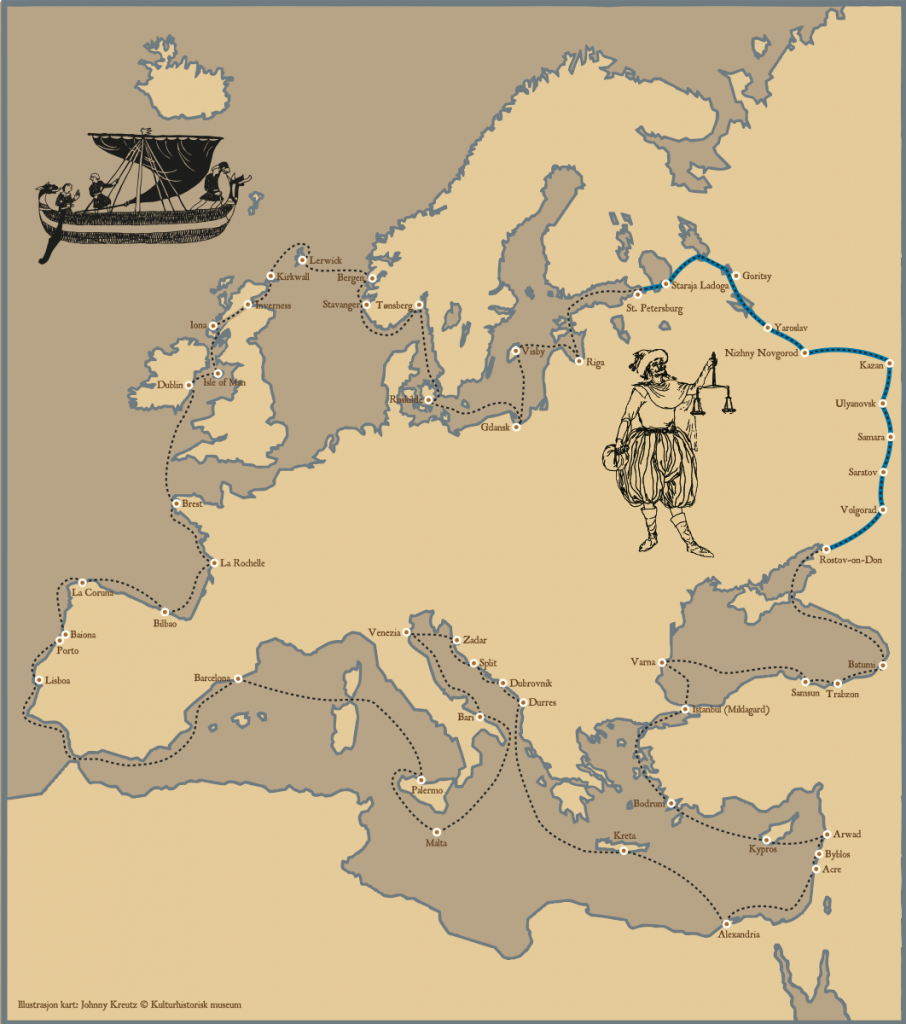
By then, the Kyiv-Rus had long been Christians, and they had also become very wealthy. The super-highway was yielding enormous riches for those who controlled it. From the north came large quantities of hides and pelts – some even from snow-white polar bears and therefore of course extremely valuable. Live birds of prey were another costly commodity, sought after especially by royals and by the Moslem courts further south and east. There were narwhale teeth (sold as unicorn horns, of course, no one in Byzantium would know the difference, anyway). They were grinded into powder and used as very potent medicine).
From the shores of the Baltic Sea came another type of luxury goods, also held in high esteem with clergy and nobles alike: amber. It was a perfect commodity for the traders; low weight, easy to transport, high yield when sold. The same goes for another category of trading goods – this one even helped with their own transportation. Slaves would arrive in trading ports in the north from many countries, often captured during Viking raids. Some would spend the rest of their miserable lives serving Viking masters in their home countries. Others would be sent south to the huge eastern slave markets, where Moslem and Byzantine traders alike were eagerly awaiting their arrival.
A recent discovery from Kyiv sheds light on another part of the trade between north and south. Tusks from walrus are not to be distinguished from ivory, in fact, they are ivory. They were sold in large quantities to royal courts, churches and monasteries, where they were used for decorating holy books, altars, knife handles etc. An interesting illustration of this special trade literally emerged in Kyiv in 2007, when a number of bone fragments from walrus sculls were unearthed. The fragments have later been DNA analysed and proven to originate from Greenland – where there were Norse/Viking settlements at the time. Contemporary Arab sources write about trade in fish teeth, this can hardly be anything else than walrus tusks.
The Kyiv discovery opens up quite a mind-blowing perspective of the super-highway, one that until now have received rather limited attention: It did not start or end in Scandinavia. Exotic Nordic trade goods could arrive in Constantinople from as far away as Greenland, perhaps even the east coast of America – the latter at least in theory, since the Vikings were there. Take a look at a world map – it´s quite an impressive journey!
The fantastic Viking ships
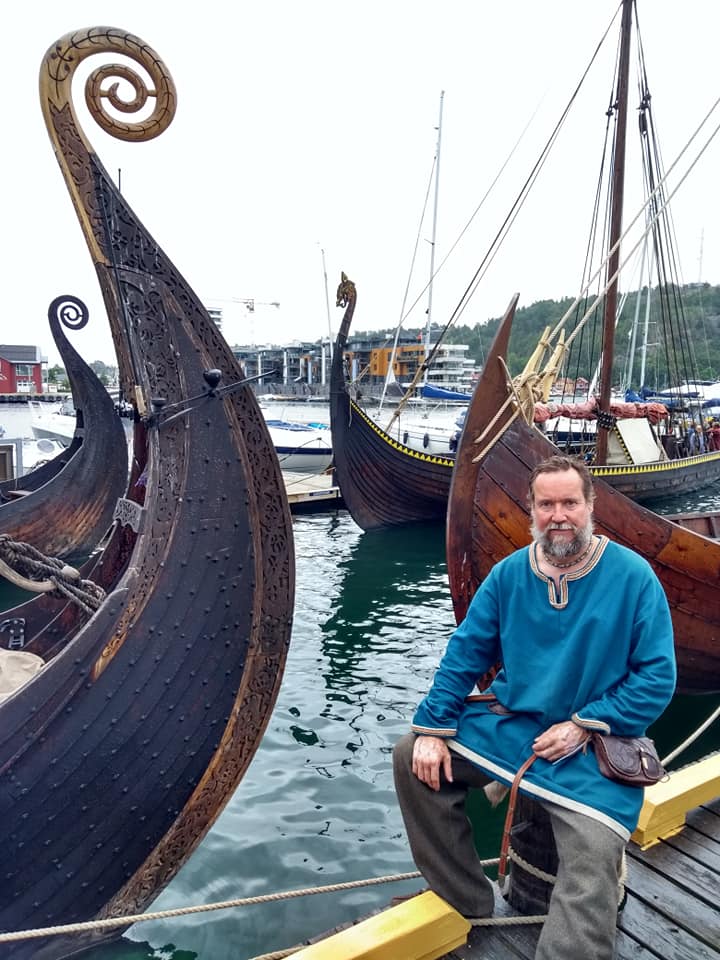
It was a journey – or rather a combination of journeys and voyages – that would not have been possible if it was not for the Vikings´ unrivalled skills as shipwrights. They started to emerge on the world scene towards the end of the 8th Century. The attack on the English monastery of Lindisfarne on June 8, AD 793 is generally considered the starting point of the Viking Age.
After that, nowhere was safe. The new ships were fast and they could attack were others couldn´t, for example by following rivers far inland to cities like London and Paris. The Viking ships were far more seaworthy than other contemporary vessels. What many do not consider when talking about Viking ships however, is that there existed a number of different types, each purpose-built for their intended line of duty.
You had, for example, the drakkar. This was the ship of the sea wolves – war ships with little space for comfort, to be rowed or sailed at high speed during attacks.
The world-famous Oseberg ship was mainly built for rising awe amongst those who witnessed her. She is sleek, with elegant curves, almost sculptural in shape. She also carries ample intricate carvings; a ship to demonstrate power and godly connections. It was a longheld apprehension that the Oseberg ship was not seaworthy, perhaps built just for the grave. This theory was effectively repudiated with the launch of our replica Saga Oseberg. After some trying and testing, she dances on the waves like a swan. Although she never was a ship for the crossing of long stretches of open seas. She was a ship built for showing off in.
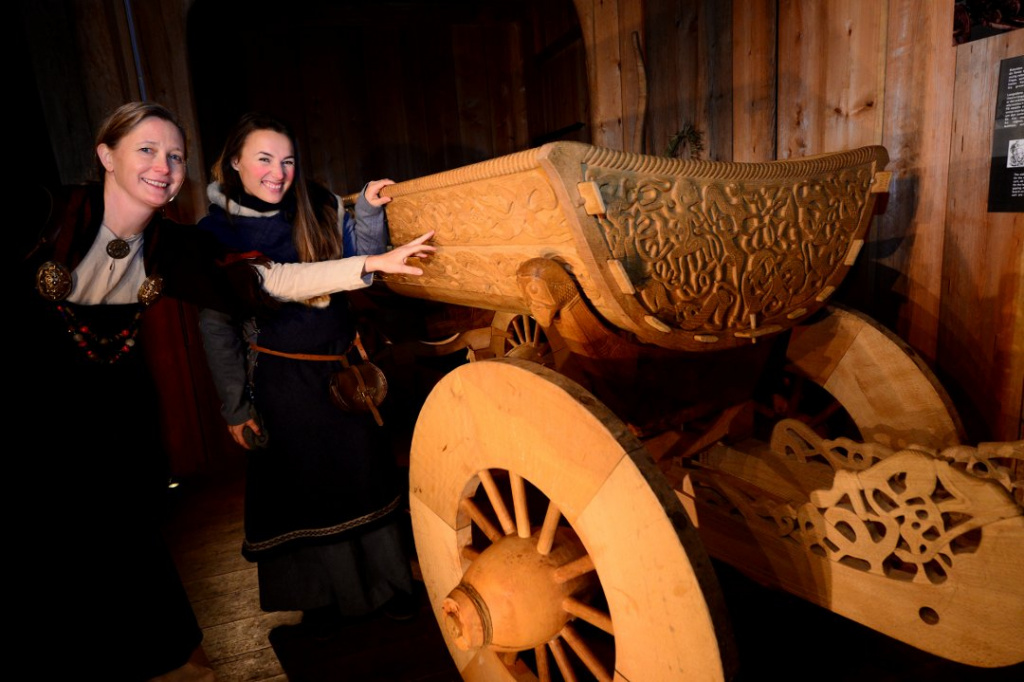
Then you have the knarr – that would be the ship type mainly used by tradesmen and explorers, a ship for long-distance sea voyages. Our Saga Farmann is such a ship. Its main purpose would be to carry cargo – not men. The crew on a 65 feet long knarr would probably be limited to 6 or 7 men, the rest of the space on board reserved for cargo. The crew could only row it over short distances and had to await favourable wind for their voyage.
It was the Volvo Truck of its day. It was ships of this type that would carry walrus teeth, polar bear hides and falcons from the Viking settlements on the west coast of Greenland. From these two settlements, they would launch hunting expeditions going much further north, seeking valuable trading goods. And as proven by Norwegian explorer Helge Ingstad and his archaeologist wife Anne Stine Ingstad, they would sometimes even visit and even settle for a while in the continent today known as America.
The sturdy knarr was the best choice of ship for transporting merchandise from Greenland to Scandinavia, and further across the Baltic Sea to one of the entrance ports to the huge network of rivers and lakes that led onwards to Kyiv and Constantinople.
You have probably heard about Vikings carrying their boats over land whenever the rivers of the east became too rough for navigation, or in sections where there were no links between two waterways. This no doubt was true.
It is, however, very unlikely that the ships in question would have been anything like the Oseberg or the Gokstad. They would simply have been too heavy and cumbersome to carry and haul through rough terrain. More likely, their big ships would have been left at Viking controlled ports along the Baltic seashore, like Wolin in today´s Poland and there exchanged for lighter, smaller boats to use on the rivers.
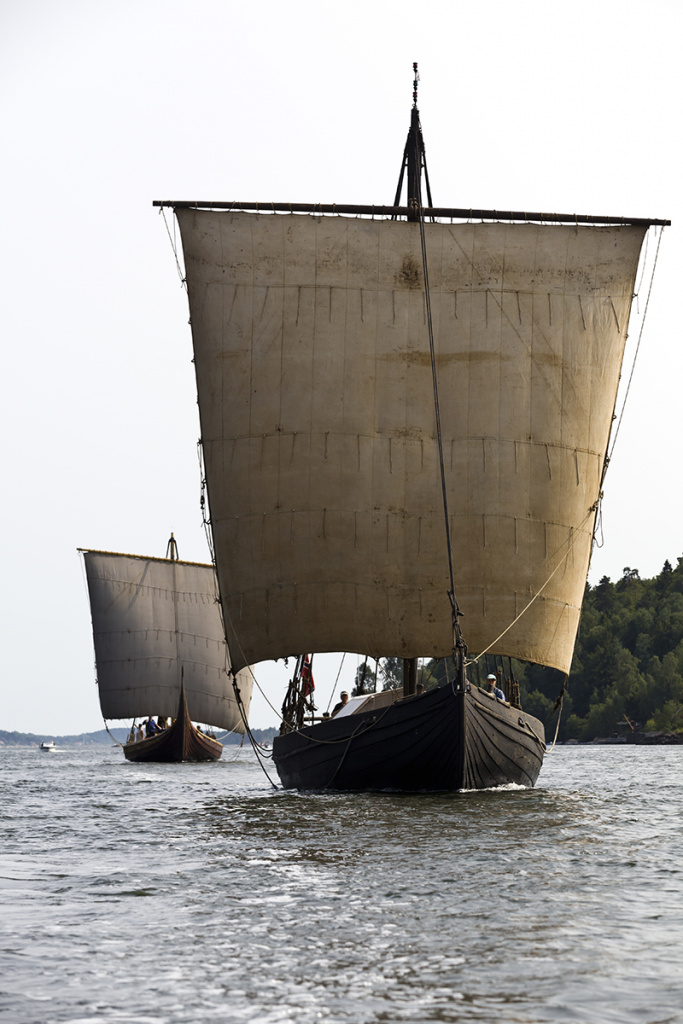
Much of the goods did of course end up in Constantinople, but there were other important trade-links following the silk roads and other routes forking out towards the south and east. Not all Viking tradesmen – or sometimes raiders – did have the Black Sea as their final destination. There was also an influx down the river Volga to the Caspian Sea. The trade between Scandinavians and Arabs must have been enormous. We can follow the trade by the sheer number of Arabic dirham silver coins from the Viking Age discovered along the routes: Over 150,000, 65,000 in Sweden alone.
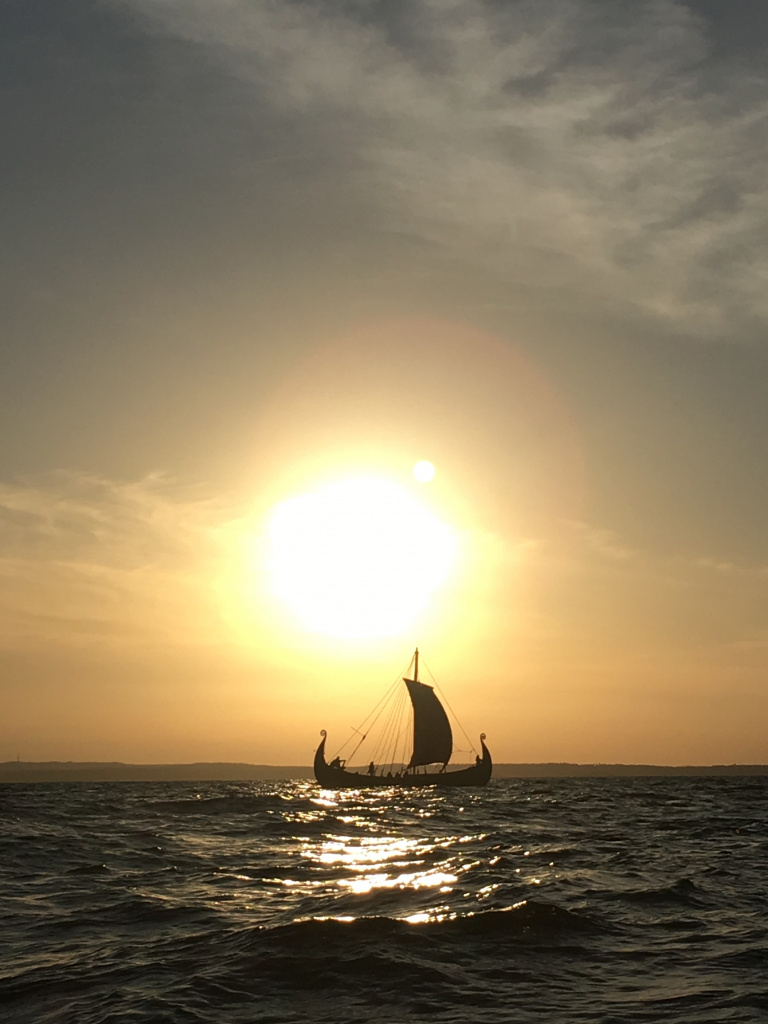
From the Black and Caspian Seas there was open access to distant and exotic lands such as Persia, India, China. Which in turn opened up for some rather unexpected goods following the trade routes up north:
When the Gokstad mound just outside Sandefjord in Norway was excavated in 1880, leading archaeologist Nicolay Nicolaysen was more than a little surprised when the remnants of two grown, male peacocks were unearthed! It is commonly known that peacocks carried great status for their mostly royal owners, bot how on earth had they found the way to Norway around AD 900? The only possible answer, of course: Along the super-highway – the road to riches.
A sensational discovery
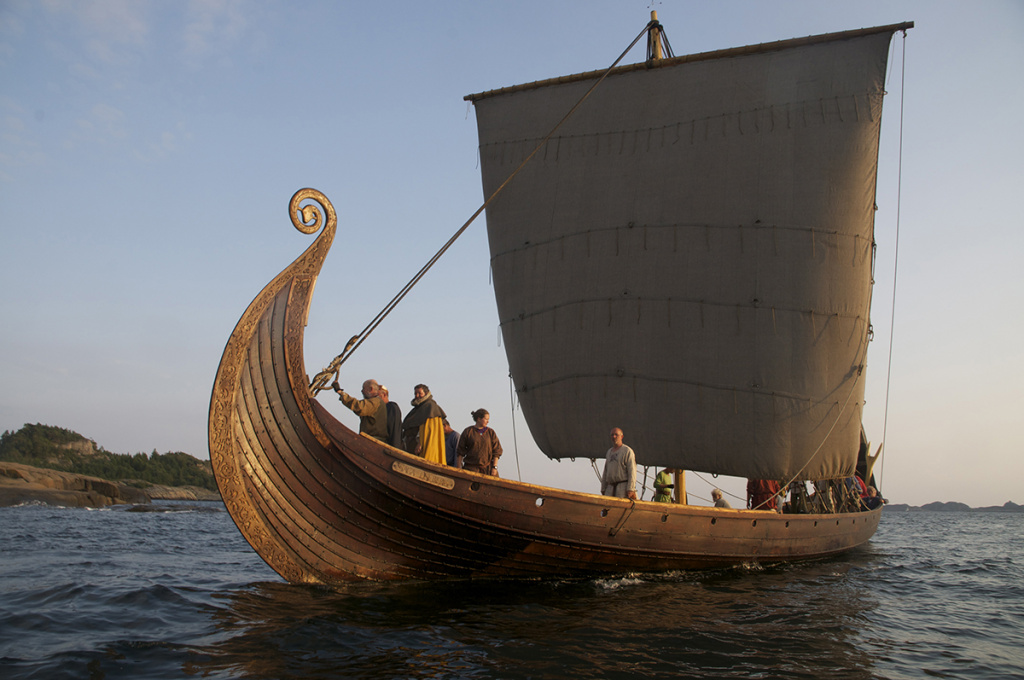
The Gokstad peacocks were by no means the only example of luxury goods travelling the other way – from south to north. As we all know: a road can be travelled in both directions. After selling their goods in Constantinople or elsewhere, Viking traders would stock up with wares that they knew would catch a good price in their own countries; all kind of luxury goods, silk and other costly materials, glass and spices.
Some of it ended up just five kilometres from where I am writing this chapter. It is a mythical landscape surrounded by legends and mysteries; the Slagen valley, just outside Norway´s oldest town Tønsberg.
For the last 1200 years, the valley landscape has been dominated by a huge, man-made mound. Its original purpose long forgotten, surrounded by legends and myths, and not a little fear, it was not until AD 1903 that the then landowner Oscar Rom started digging into it. Yellow, foul-smelling liquid soon started to ooze out, seemingly confirming the rumours that victims of the feared Black Death were buried under the mound.
But Mr Rom stubbornly continued to dig and was soon well rewarded. Up from the stinking slush came a piece of well-preserved oak wood, richly decorated in intricate carvings unlike anything he hade ever seen before. He knew he was into something really big.
The next day he brought the piece of wood with him on the train to Oslo (then: Christiana). He insisted on seeing Norway´s leading expert on archaeology, professor Gabriel Gustafson. Who, in turn, was rather reluctant in letting him into his office. He was fed-up long ago by all those who came to see him, claiming sensational discoveries. Furthermore, the day was his fifty years birthday, so he wanted to get home to his family as soon as possible.
Few archaeologists can have received a more spectacular birthday present than what Oscar Rom brought professor Gustafson that day. The Oseberg find can easily defend its position on the top-ten list of last century´s most important archaeological discoveries. The contents were remarkably well preserved. This was the result of the mound having been covered first in clay, on top of that turf. The result was an almost airtight mound, like a sealed tin can.
The mound had been plundered within a generation or two after it was constructed in AD 834. Any objects of precious metal that might have been in the grave originally were therefore no longer there. But what still remained made a word-wide sensation as it was revealed during the excavations that took place during the summer of 1904.
First of all, there was of course the ship. It was 21.5 meters long, with space for 30 rowers and a crew of another 20. The weight of the mound itself had pressed and twisted the ship almost flat, but the remarkable thing was: Almost all ship parts where present, wonderfully preserved. Some 95 per cent of the ship could be identified and used at a later stage during reconstruction.
This time however, it´s not the ship that is of the greatest interest to us. It’s the burial chamber and its two occupants.
Two mysterious women – and silk
The two skeletons had been rough-handled by the grave robbers, who had dragged the remains into the passage used during the break-in. The robbers had then cracked open some eight or nine solid oaken chests, all heavily locked and perhaps were gold or other valuables had been kept. But in the rather sinister and dark environment of the grave they had overlooked one chest. Its contents had direct relevance to the links between the Viking world and the Byzantine Empire, so we shall return to it later.
Another rather unexpected link appeared more than a hundred years after the 1904 excavations. It had to do with the two persons that were in the grave. So who were they?
1904 was a time of great political change in Norway. Vikings were in demand as never before in newer history – and they had arrived just in time. The country needed heroes as it was on the brink of breaking loose from the forced 1814 union with Sweden. Before 1814 the country had been more or less a colony under Denmark for 400 years. In the name of nation-building, Norway desperately needed to demonstrate that it too had a glorious past.
The Vikings could supply that. So Professor Gustafson´s archaeology team expected of course to find more or less the same as their colleagues had almost 25 years ago, when the Gokstad mound was excavated in1880: A great ship, fully equipped for the afterlife for a powerful Viking chieftain.
They couldn´t have been more wrong. As professor Gustafson unbelievingly wrote is his excavations logbook after studying the brittle human remains yet one more time: “But this must be women?” And indeed they were.
So who were they? Bearing in mind Norway´s great emphasis on a proud history (the ties with Sweden were finally cast off the very next summer, in 1905), it was important to give the women a powerful identity. So what could be better than if one was Åsa (explaining the Osa prefix of the local place-name) while Åsa also happened to be the name of the grandmother of king Harald Fairhair, (born around 850, dead 931/932). This was the king supposed to have united Norway into one kingdom, so what could be better than finding his grandmother?
And this we believed until the 1990ies. Sometimes the odds of being Åsa were on the oldest women, sometimes on the younger one. It was not really important.
But it would become important. In the 1990ies technologies for dating archaeological material had improved immensely. New samples were taken, including from the burial chamber. They gave exact dating: The Oseberg ship was built in AD 820 and placed in the mound in the autumn of AD 834. Neither of the women fitted in with the little we knew about queen Åsa.
So, in 2007, local archaeological authorities decided to unearth the aluminium chest containing the human remains. These had been reburied in 1948, now there was a growing concern that the chest might not be entirely watertight.
It was rescue in high time. Another few years, and the skeletal remains would have disintegrated completely. Instead, they could now be analysed again, using modern methods and techniques. The results were some rather important discoveries – as well as some rather surprising ones.
Perhaps the most amazing facts were the women´s age. The younger was around fifty years old when she died – the older woman probably around eighty. Which alone would have set her apart as a very special person in a society where average life expectancy was little more than 30 years!
Both women were approximately 153 cm tall and judged by their diet they had belonged to the upper class of Viking society. It was also discovered that the elder woman had suffered from cancer in her lower abdomen. At some time during her youth she had had a bad back injury, almost certainly forcing her to walk with a strong stoop for the rest of her life. Add to this a hormone disturbance that made her body produce large amounts of male hormones. In other words: she would likely have had a deep voice and could well have grown a beard!
So, however difficult, try to imagine a short (and most likely fat) old woman permanently bent over, talking in a deep voice and sporting a full beard. She had lived “forever”, she was both man and woman. To her contemporaries she must have seemed quite a character, indeed!
The remains of the younger woman also hid quite a surprise. DNA-analyses revealed links to the area around the Black Sea! Unfortunately, the remains had been contaminated with foreign DNA from earlier handlers, so it is not possible at present to be more specific about her origins.
But the Oseberg find held other “Byzantine” secrets as well. So let us see what was inside the ninth oaken chest, the one the grave robbers missed. We can almost feel the tension and excitement among the spectators when the locked chest was pried open. Then came the disappointment: the chest contained nothing but sewing equipment and remnants of cloth!
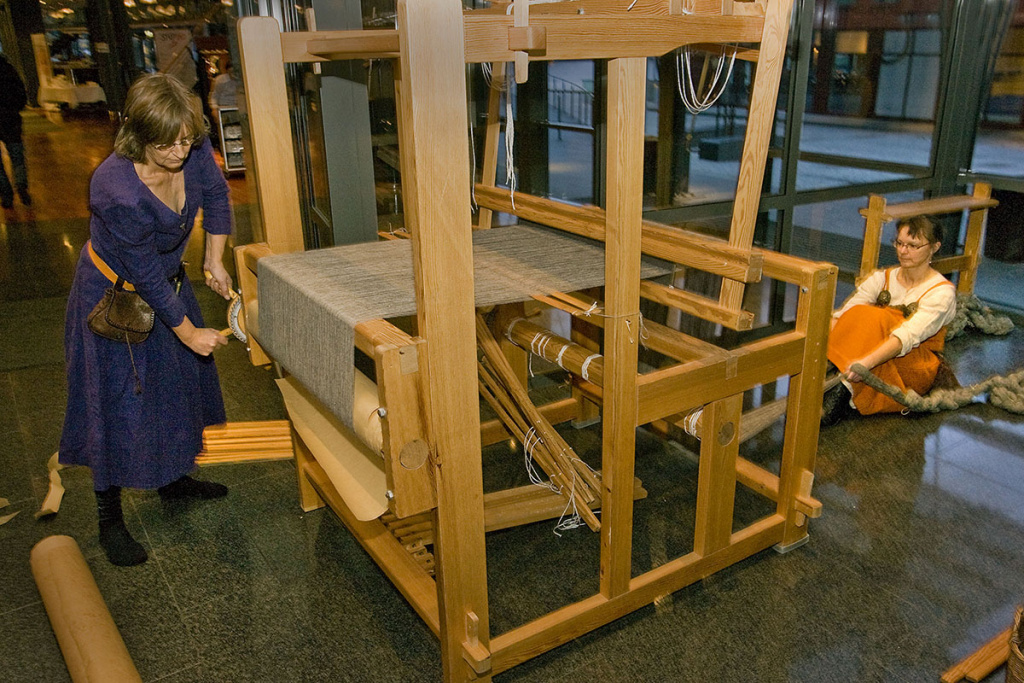
But wait – perfectly preserved cloth from the 9th century, sparkling in colours? How often does one find that? In truth: very rarely. The all-male excavation team however, showed only limited interest in these and the hundreds of other pieces of cloth that were discovered at Oseberg. Fortunately, Sofie Krafft worked as a conservator and an illustrator during the excavation. During the work to conserve several types of textiles, she placed them in a water bath. Then, she saw how the original colours emerged and drew as many as time allowed – which sadly was by no means enough.
It was not until our times, however, that new, targeted research on the Oseberg textiles has been undertaken. Professor Marianne Vedeler at the Museum of cultural history/University of Oslo has revealed that much of the silk and brocade at Oseberg originated in Constantinople. They had followed the road to riches – in the opposite direction.
The Varangian Guard
There was yet another “commodity” that followed the Road to riches from north to south during several hundred years: Men, namely warriors. They came to seek their fortune as members of the Emperors bodyguard, the Varangian Guard. We don´t know when the first Scandinavian mercenaries arrived in the Great City, but there exists an account from AD 839 which relates to Swedish envoys to the imperial court.
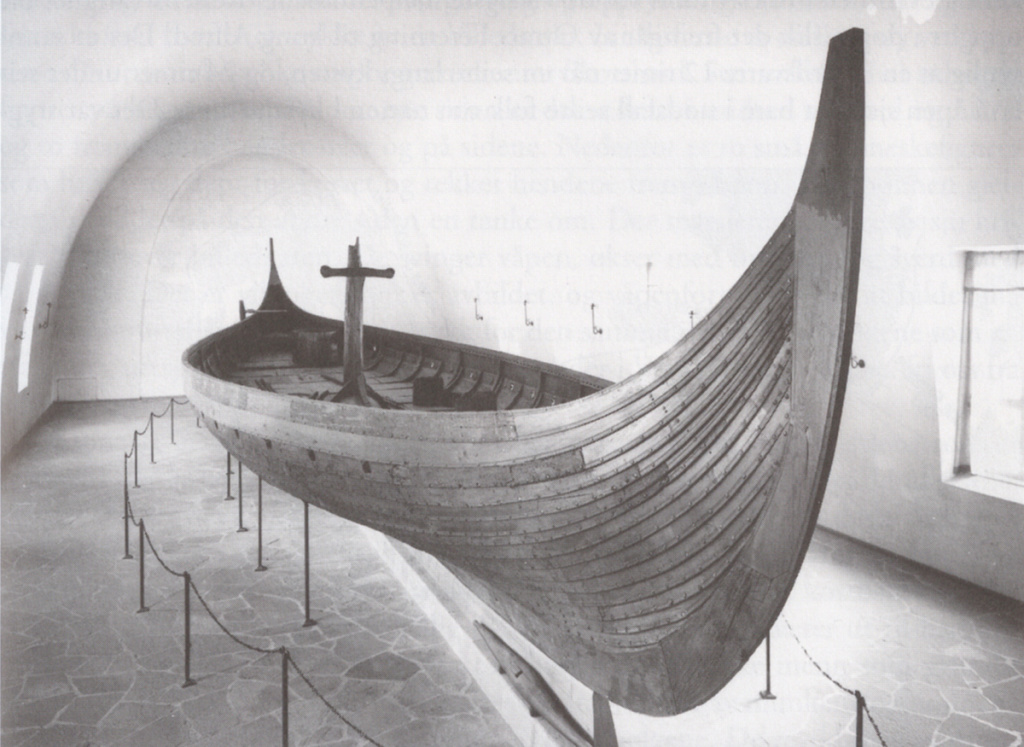
So it´s a fair guess that the first Scandinavian recruits would have enlisted sometime around the middle of the 9th century. In the beginning they would likely arrive in small groups, but from the second part of the 10thcentury, Scandinavian mercenaries were systematically recruited. Theirs was a reputation for ruthlessness and great courage. Seen with the emperor´s eyes, they also had another great quality: they did not have commitments or links to any of the fractions that almost constantly struggled for influence and power around the imperial court. The Varangians could be trusted – or rather, at least more so than others.
To young, adventure-seeking Scandinavians, guard duty represented a fantastic opportunity. Each of them could earn up to 44 gold coins per year, a huge amount. They could also claim a share in the spoils after a battle or a conquest. Also, the Vikings had negotiated a rather lucrative agreement: each time an emperor died, his bodyguard had three days to go through his personal belongings and take with them as loot as much as they could carry.
We have already met Harald the Hard Ruler (1015-1066) in Kyiv. He was to become the most famous among all the Vikings serving the Byzantine emperor. He was later to become king of Norway and came very close to become the conqueror of England.
After barely surviving a battle in Norway (AD 1030), he followed the Road to riches and did not stop until arriving at Jaroslav the Wise’s court in Kyiv, where he was welcomed. After healing from his wounds, Harald agreed to work in Jaroslav´s service as a commander of the princely bodyguard, winning glory and goods during several military expeditions against Jaroslav´s enemies.
Jaroslav had a daughter named Elisaveta (Elisabeth). Harald asked for her hand in marriage, but Jaroslav would not give her to a man with few prospects of becoming a ruler one day. But he did not reject Harald entirely:
“So far, you are a man without a country. But if you prosper as I expect you to do, I shall not deny you for all future,” he said.
So the Norwegian king in the making got the message: If he wanted Elisaveta´s hand in marriage, he´d better go out in the world and make a fortune and a reputation for himself. Which is what he did, even more so than his future father-in-law could expect.
Harald enlisted with the Varangian guard, first to become a naval commander, later one of the highest-ranking imperial guard officers. He led a number of successful expeditions around the Mediterranean, all the while collecting enormous hoards of coins, gold, silk and other valuables. When he finally returned to Norway it was said that never before had such treasure reached the Nordic countries.
Before we leave Harald the Hard Ruler, let us dwell with a story told in his saga that just might or might not be true. He had fallen out with the notorious Empress Zoë (c. 978-1050), the real ruler of the Byzantium Empire at the time. She was definitely not one would want as an enemy, so Harald decided it was time to leave. But he had a problem: His ship was anchored inside the massive iron chain that sealed off the Golden Horn in times of trouble. Harald´s ship hit the chain at full rowing speed while he commanded all on board to run aft, thus lifting the bow section on top of the chain. Then, all crew ran to the bow, thus tipping the ship over the hindrance and into the waters of the Bosporus.
The course was then speedily set for Ellipaltar, where river Dnjepr empties into the Black Sea. From there, they lost no time in reaching their next destination, Kyiv. And of course, Harald got the permission to marry Elisaveta – who under the name Ellisiv became queen of Norway. Her portrait can still be seen in a mural at Kyiv´s Santa Sophia cathedral.
In the mists of history
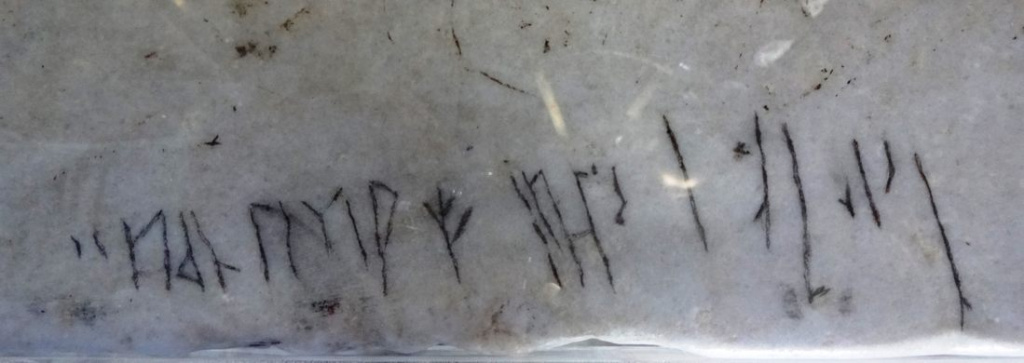
Vikings have a reputation for having some rather violent strikes, and perhaps deservingly so. But remember, theirs were violent times, and it is difficult to see that they were dramatically different from many of their contemporaries. So at least in the context of this book, we have rather looked into two other aspects of Viking society: as tradesmen and explorers. So let us for a short while delve even deeper into the mists of history and see what we might find. Let´s go to Troy!
We all know the story, originally told by Homer (c. 800 BC), and then the drama surrounding German archaeologist Heinrich Schliemann´s discovery at Hissarlik mound on the Küçük Menderes River near the mouth of the Dardanelles. Today, the site is generally acknowledged as where the legendary town once stood. But interesting enough, it is also where “the father of Scandinavian history-writing”, Snorre Sturlasson (1178-1241) places the origin of the Norse Pantheon. In his Edda – a textbook in the art of poetry, but also in Norse mythology, he writes that the Norse goods originally were men and princes of Troy who had wandered north until reaching the old Swedish town of Sigtuna and there established a dynasty of godkings, with Odin (Wotan) the most prominent among them.
It is interesting to note – that Snorre is not the only author who points to Troy as origin of a great dynasty. Roman poet Vergil (70-14BC) lets his mythical hero Aeneas flee the burning Troy, finally to settle down in what would become a mighty city: Rome.
Be that as it might, it´s time to return to young Halfdan where we left him when starting out on this journey through distant lands, facts and myths. He is still standing at the balustrade of Hagia Sophia – and he is extremely bored. The service below him has been going on for hours. To start with, he kind of enjoyed the song and music resounding under the large cupola, it was as the whole cathedral was transformed into one enormous instrument. But the service seemed to go on and on forever, and of course in a language Halfdan did not much understand. Even so, he did not dare to leave the place before the service was over, his commanding officer at the emperor´s bodyguard – a Scandinavian like himself – had made that very clear.
So what did Halfdan do? He carefully looked over his shoulder before pulling out his short, sharp knife. And in runic letters he carved out in the pure marble a short message many a bored youngster had written down both before him and after him: Halfdan was here. A few other runic inscriptions have been discovered in Hagia Sophia as well, and some drawings of Viking ships. So Halfdan was undoubtedly there – as we still can witness, more than a thousand years later.

